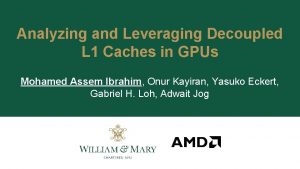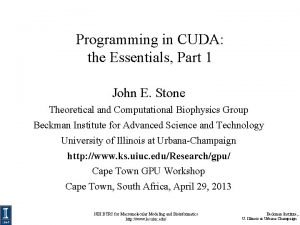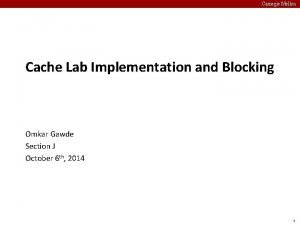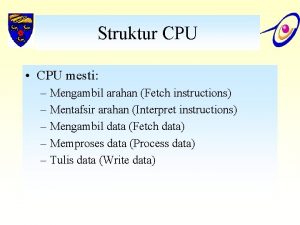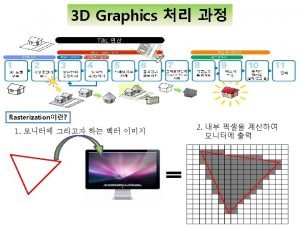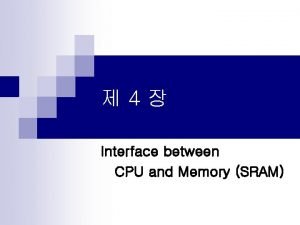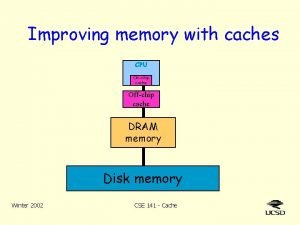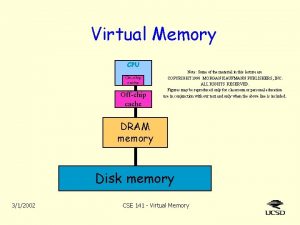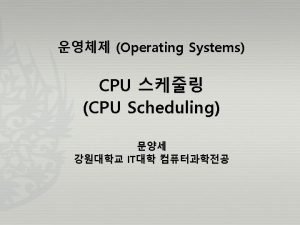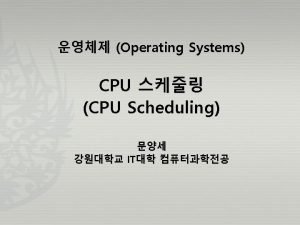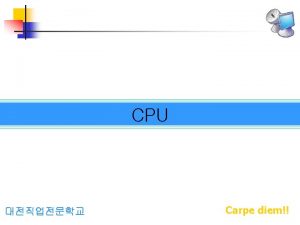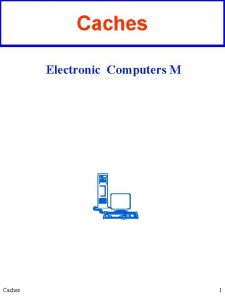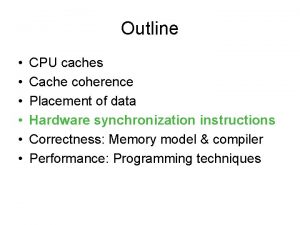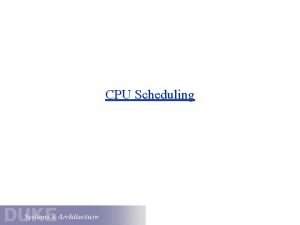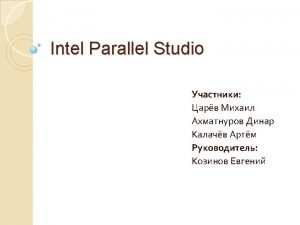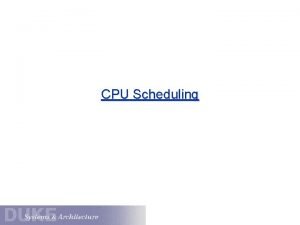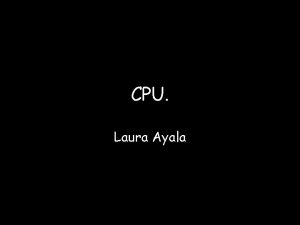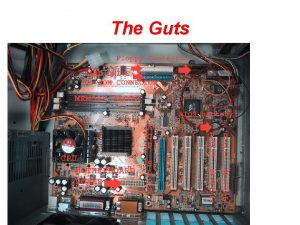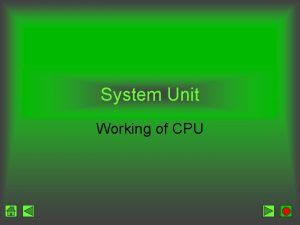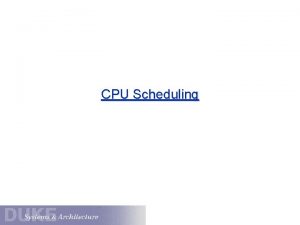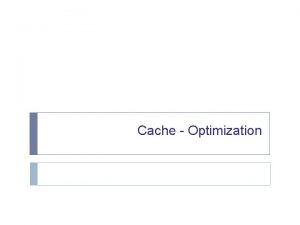Caches part II CPU Onchip cache Offchip cache


















- Slides: 18

Caches, part II CPU On-chip cache Off-chip cache DRAM memory Disk memory 2/27/2002 CSE 141 - Cache II

Details X • What bits should we use for the index? X • How do we know if a cache entry is empty? • Are stores and loads treated the same? • What if a word overlaps two cache lines? ? X • How does this all work, anyway? ? ? 2 CSE 141 - Cache II

Accessing a Sample Cache • 32 KB cache, 2 -way set-associative, 16 -byte block size 31 30 29 28 27. . . 17 16 15 14 13 12 11 10 9 8 7 6 5 4 3 2 1 0 tag index word offset 10 18 valid tag data valid tag 32 KB / 16 bytes / 2 = 1 K cache sets 0 1 2. . data . . . 1021 1022 1023 = = hit/miss 3 CSE 141 - Cache II

Dealing with Stores • Stores must be handled differently than loads, because. . . – they don’t necessarily require the CPU to stall. – they change the content of cache Creates a memory consistency question. . . how do you ensure memory gets the correct value? the one in cache 4 CSE 141 - Cache II

Policy decisions for stores • Do you keep memory and cache identical? – write-through cache: all writes go to both cache and main memory – write-back cache: writes go only to cache. Modified cache lines are written back to memory when the line is replaced. • Do you make room in cache for store miss? – write-allocate: on a store miss, bring target line into the cache. – write-around: on a store miss, ignore cache 5 CSE 141 - Cache II

Dealing with stores • On a store hit, write the new data to cache. – In a write-through cache, write the data immediately to memory. – In a write-back cache • Mark the line as dirty. – means cache has correct value, but memory doesn’t • On any cache miss in a write-back cache, if the line to be replaced in the cache is dirty, write it back to memory. • On a store miss, – In a write-allocate cache, • Initiate a cache block load from memory. – In a write-around cache, • Write directly to memory. 6 CSE 141 - Cache II

Cache Alignment memory address: tag index • A cache line is all the data whose address share the tag and index. Example: Suppose offset if 5 bits, • Bytes 0 -31 form the first cacheline • Bytes 32 -63 form the second, etc. – When you load location 40, cache gets Bytes 32 -63 • This results in – no overlap of cache lines – easy to find if address is in cache (no additions) – easy to find the data within the cache line offset Memory 0 1 2 3 4 5 6 7 8 9 10. . . • Think of memory as organized into cache-line sized pieces (because in reality, it is!) 7 CSE 141 - Cache II

Can a word overlap two cache lines? • Depends on the architecture. . . – Some require words to be word-aligned. . . • and double words to be double-word aligned • Every load and store is to a single cacheline – Others allow data to span cache lines • Can be two cache misses for a single reference! • Requires more shifting logic • But allows more compact data structures. 8 CSE 141 - Cache II

Cache Vocabulary • miss penalty: extra time required on a cache miss • hit rate: fraction of accesses that are cache hits • miss rate: 1 - hit rate 9 CSE 141 - Cache II

A Performance Model • TCPI = BCPI + MCPI – TCPI = Total CPI – BCPI = Base CPI = CPI assuming perfect memory – MCPI = Memory CPI = cycles waiting for memory per instruction • BCPI = peak CPI + PSPI + BSPI – PSPI = pipeline stalls per instruction – BSPI = branch hazard stalls per instruction • MCPI = accesses/instruction * miss rate * miss penalty – this assumes we stall the pipeline on both read and write misses, that the miss penalty is the same for both, that cache hits require no stalls. – If the miss penalty or miss rate is different for I-cache and Dcache (which is common), then MCPI = Inst. MR*Inst. MP + Data. Accesses/inst*Data. MR*Data. MP 10 CSE 141 - Cache II

Cache Performance • Instruction cache miss rate of 4%, data cache miss rate of 9%, BCPI = 1. 0, 20% of instructions are loads and stores, miss penalty = 12 cycles, TCPI = ? • Unified cache, 25% of instructions are loads and stores, BCPI = 1. 2, miss penalty of 10 cycles. If we improve the miss rate from 10% to 4% (e. g. with a larger cache), how much do we improve performance? • BCPI = 1, miss rate of 8% overall, 20% loads, miss penalty 20 cycles, never stalls on stores. What is the speedup from doubling the cpu clock rate? 11 CSE 141 - Cache II

Three types of cache misses • Compulsory misses – number of misses needed to bring every cache line referenced by program into an infinitely large cache. • Capacity misses – number of misses in a fully associative cache of the same size as the cache in question minus the compulsory misses. • Conflict misses – number of misses in actual cache minus number there would be in a fully-associative cache of the same size. Total misses = (Compulsory + Capacity + Conflict) misses • Example: 4 -word direct-mapped, 1 word per cacheline – Reference sequence: 4, 8, 12, 4, 8, 20, 24, 12, 8, 4 • Compulsory misses: • Capacity misses: • Conflict misses: 12 CSE 141 - Cache II

So, then, how do we decrease. . . • Compulsory misses? • Capacity misses? • Conflict misses? 13 CSE 141 - Cache II

LRU replacement algorithms • Not needed for direct-mapped caches • Requires one bit per set for 2 -way set-associative, 8 bits per set for 4 -way (2 bits per entry), 24 bits per set for 8 -way, etc. • Can be approximated with k-1 bits per set – One bit says which half was less recently used – Each half has one bit says which quarter is LRU, . . . • Cheaper approach is to use random replacement within a set. Miss rate is about 10% higher than LRU. • Highly associative caches (like page tables, which we’ll get to) use a different approach. 14 CSE 141 - Cache II

Caches in Current Processors • Often direct mapped level 1 cache (closest to CPU), associative further away • Split I and D level 1 caches (for throughput rather than miss rate), unified further away. • Write-through and write-back are both common, but never write-through all the way to memory. • Cache line size at least 32, getting larger. Usually cache is non-blocking – processor doesn’t stall on a miss, but only on the use of a miss (if even then) – this means the cache must be able to handle multiple outstanding accesses. 15 CSE 141 - Cache II

Example -- DEC Alpha 21164 Caches I-Cache 21164 CPU Unified L 2 Cache Off-Chip L 3 Cache D-Cache ICache and DCache -- 8 KB, Direct Mapped, 32 -Byte lines L 2 cache -- 96 KB, 3 -way Set Associative, 32 -Byte lines L 3 cache -- 1 MB, Direct Mapped, 32 -byte lines (but different L 3’s can be used) 16 CSE 141 - Cache II

Cache Review memory address: tag index offset DEC Alpha 21164’s L 2 cache: 96 KB, 3 -way set associative, 32 -Byte lines 64 bit addresses How many “offset” bits? How many “index” bits? How many “tag” bits? Draw cache picture – how do you tell if it’s a hit? 17 CSE 141 - Cache II

Computer of the Day • The first Macintosh • “ 1984” Superbowl advertisement shown only once – see www. apple-history. com/quickgallery. html • Motorola 68000 processor – 8 MHz, 128 KB memory • 13. 5” x 9. 5” x 11”. 16. 5 pounds • Had mouse, small b/w monitor, built-in floppy drive, and backpack. Cost $2, 495. • First commercial computer with a GUI. Incredibly easy to use compared to DOS, . . . 18 CSE 141 - Cache II
 L caches
L caches Analyzing and leveraging decoupled l1 caches in gpus
Analyzing and leveraging decoupled l1 caches in gpus John cuda
John cuda Cachelab part b
Cachelab part b Part whole model subtraction
Part whole model subtraction Footed ware glass
Footed ware glass Part to part ratio definition
Part to part ratio definition The part of a shadow surrounding the darkest part
The part of a shadow surrounding the darkest part Part part whole
Part part whole 미니탭 gage r&r 해석
미니탭 gage r&r 해석 Part by part technical description example
Part by part technical description example Struktur cpu
Struktur cpu Lmc branching
Lmc branching General purpose cpu
General purpose cpu Fcfs gantt chart
Fcfs gantt chart Mmon_slave high cpu
Mmon_slave high cpu Maqueta de las partes internas del cpu
Maqueta de las partes internas del cpu Cpu sram
Cpu sram Uno-r logo
Uno-r logo

